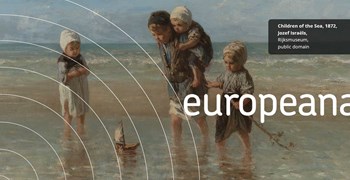Slovak painting in the era of Art Nouveau
This week’s guest post for our Art Nouveau season comes from Lukáš Štepanovský of the Slovak National Gallery in Bratislava.
The regional variations of Art Nouveau, known as Sezession in Slovak, around Europe were marked and diverse. At that time, the territory of today’s Slovakia was part of the Austro-Hungarian Empire. Despite being a crossroads of cultures in a geographical sense, Austria-Hungary had a very provincial political status and an underdeveloped art school tradition. Europe’s principal art academies were situated in cities like Prague, Munich and Paris, and many talented Slovak artists chose to stay on after their studies, such as Viktor Oskar Tilgner in Vienna and Alojz Stróbl in Budapest.
The Slovak towns Pressburg (today’s Bratislava), Komárno, Detva and Košice represented regional artistic hubs, centred around private art schools like the Karol Harmos school in Komárno, and artistic groups like the Pressburger Kunstverein, which brought European influences to the local art scene. The wider adoption of Art Nouveau, however, was hindered by the conservative tastes of the Slovak public, who preferred more traditional 19th century styles.

Ladislav Mednyánszky, Lady with shuttles, ca. 1875-1885, Strážky collection, Slovak National Gallery, CC BY
Art Nouveau in Slovak art was characterised by subtle stylistic elements taken from Impressionism, Symbolism and Luminism. Beyond its influence on colour and tone, light was often used as a decorative and thematic element in itself, creating less representational and more mystical works. The contemporary fascination with Theosophy resulted in many artworks containing melancholic figures lost in thought, focused on their inner world. Landscapes sometimes used unusual colour hues and strange weather effects to create peculiar, otherworldly atmospheres, as in Ladislav Mednyánszky’s Praying over the Grave from around 1895.

Ladislav Mednyánszky, Praying over the Grave, ca. 1895, Strážky collection, Slovak National Gallery, CC BY
Mednyánszky (1852-1919) was one of the most important and prolific Slovak masters working at the turn of the century. He combined diverse European art influences with an interest in Eastern philosophy and a particular empathy for his subjects. Although an avid painter of native realist subjects, such as poverty and disease, Mednyánszky also sought to convey the inner worlds of his characters.
Martin Benka (1888-1971), called “the alchemist of Slovak beauty” by his contemporaries, was the founder of a nationally oriented school of painting. Before becoming a well-known figure on the Slovak art scene, Benka studied under the Czech artist Alois Kalvoda and inherited some of his teacher’s inclination towards Art Nouveau and Impressionist styles. Benka’s atmospheric and unusually coloured early landscapes were complemented by scenes of Slovak folk interiors. In these almost cozy works we can see a hint of Art Nouveau arabesque and a “calligraphic” gesture, indicating a fascination with the folklore, which stayed with the artist well into his later endeavours.

Konštantín Kövári-Kačmarik, In the Morning Sun (Village Courtyard), 1910, Slovak National Gallery, Public Domain
Konštantín Kövári-Kačmarik (1882-1916) was a singular artist who diligently worked to advance Art Nouveau forward in Košice, before the city became an interwar centre of Slovak Modernism. His views of the city’s streets, corners and courtyards used light and colour as decorative elements. Kövári-Kačmarik’s art represents a bridge between Art Nouveau and Symbolism, and his work was crucial to the later development of Slovak Modernism.

Anton Jasusch, Yellow Mill, 1922, Collection of Modern and Contemporary Painting, Slovak National Gallery, In Copyright
Anton Jasusch (1882-1965) also worked in Košice and employed elements of Art Nouveau style in the period before the outbreak of the First World War. After being drafted into the army, injured on the eastern front and captured, Jasusch was cut off from the mainstream of European art trends. On returning home, Jasusch retreated into isolation and produced the series of large canvases which are today seen as his masterpieces. Channelling his war trauma into apocalyptic visions of swirling colour and world-crushing momentum, Jasusch elevated his gestural detail and vibrant hues above mere decoration. These intensely dynamic and almost Futurist compositions have no equivalent in Slovak art before or since.














